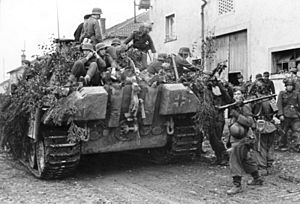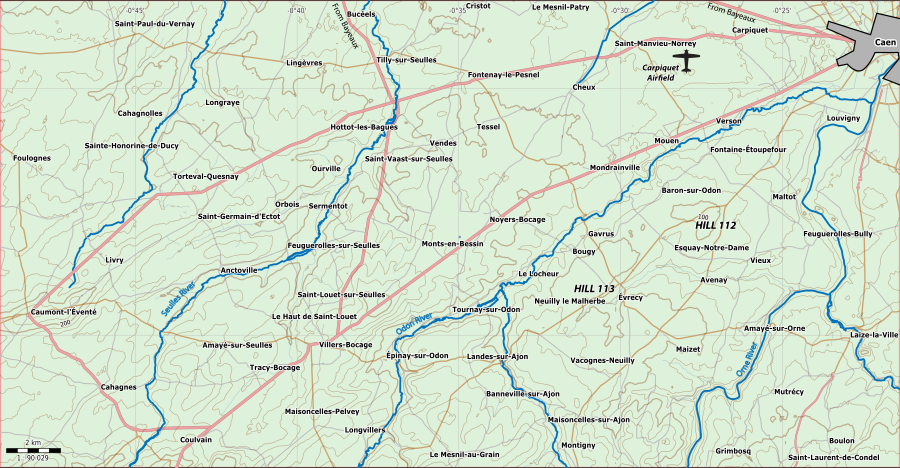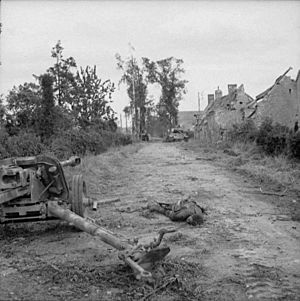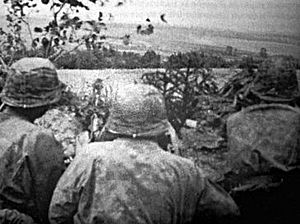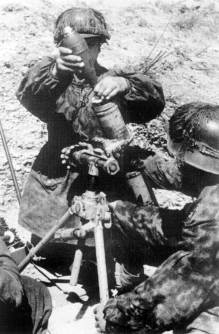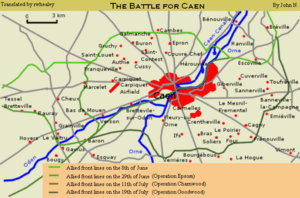Operation Epsom facts for kids
Quick facts for kids Operation Epsom |
|||||||
|---|---|---|---|---|---|---|---|
| Part of the Battle for Caen | |||||||
 An ammunition carrier of the British 11th Armoured Division explodes after it is hit by a mortar round during Operation Epsom, 26 June 1944. |
|||||||
|
|||||||
| Belligerents | |||||||
| Commanders and leaders | |||||||
| Strength | |||||||
| 2 infantry divisions 1 armoured division 1 armoured brigade 1 tank brigade |
3 SS panzer divisions 5 ad-hoc battle groups 1 SS heavy tank battalion |
||||||
| Casualties and losses | |||||||
| 4,020–4,900 casualties 150 tanks damaged or knocked out |
Over 3,000 casualties 125–126 tanks damaged or knocked out |
||||||
| Operation Epsom | |
|---|---|
| Operational scope | Strategic Offensive |
| Planned by | British Second Army |
| Objective | Break out of the bridgehead west of Caen, advance across the Orne River and capture the high ground south of Caen, near Bretteville-sur-Laize |
| Executed by | VIII Corps, Second Army; supporting attacks made by elements of XXX Corps. |
| Outcome | See Aftermath section |
Operation Epsom, also known as the First Battle of the Odon, was a major British attack during the Second World War. It took place between 26 and 30 June 1944, as part of the larger Battle of Normandy. The main goal of Operation Epsom was to go around and capture Caen. This city was a very important target for the Allied forces early in the invasion of north-west Europe.
Before Epsom, a smaller operation called Operation Martlet helped secure the right side of the British advance. Operation Epsom started on 26 June. British soldiers from the 15th (Scottish) Infantry Division moved forward behind a wall of artillery fire. Air support was limited because bad weather in England stopped bomber planes from taking off. The Scottish Division, with tank support, made good progress. By the end of the first day, they had pushed through most of the German defenses.
Over the next two days, there was tough fighting with many losses on both sides. The British managed to cross the River Odon. They then tried to expand this area by taking important points. By 30 June, after strong German counter-attacks, some British forces pulled back from across the river. The ground they had captured was made secure, and the operation ended.
Both sides had many casualties. However, unlike the Allied commander Bernard Montgomery, the German commander Erwin Rommel could not pull his units back. They were needed to hold the front line. The British kept the advantage and attacked several more times. They captured Caen in Operation Charnwood in mid-July. Experts have different ideas about Operation Epsom. But they agree it greatly affected the balance of power in Normandy. The Germans stopped the British attack, but only by using all their strength. This included two panzer divisions that had just arrived and were meant for a different attack.
Contents
Why the Battle Happened
The city of Caen was a key target for the British 3rd Infantry Division on D-Day, 6 June 1944. Capturing Caen was seen as the most important D-Day goal for the British I Corps. The overall plan, Operation Overlord, aimed for the British Second Army to secure Caen. Then, they would create a front line to protect the American army's left side. This would allow the Americans to fight the Battle of Cherbourg.
Taking Caen would give the British a good starting point to push south towards Falaise. This would help them advance further into France. However, the 3rd Infantry Division could not attack Caen directly on D-Day. They were slowed by crowded beaches and strong German positions. The 21st Panzer Division stopped them just outside the city. Later attacks also failed as more German troops arrived.
The British tried a different approach with Operation Perch on 7 June. This was a pincer attack to surround Caen from the east and west. But German forces, like the Panzer-Lehr-Division, stopped these attacks too. A part of the 7th Armoured Division tried to push through a gap and captured Villers-Bocage. But they were ambushed and had to pull back. Still, by 17 June, the Germans had been pushed back, and the British took Tilly-sur-Seulles.
Another planned attack was stopped when a big storm hit the English Channel on 19 June. The storm lasted three days and delayed Allied supplies. Many ships were forced back to Britain. This gave the Germans time to improve their defenses. They placed minefields and dug in many powerful 88 mm guns around Caen.
Planning the Attack
On 20 June, German Field Marshal Erwin Rommel was ordered to launch a counter-attack. His goal was to cut off the American and British armies. He wanted to recapture Bayeux and the coast. Four SS panzer divisions and one German army panzer division were assigned this task. These included the 9th SS Panzer Division and 10th SS Panzer Division, which had just arrived from the Eastern Front.
On 18 June, General Montgomery ordered a new pincer attack to capture Caen. The plan was for the British VIII Corps to lead the main attack. This corps had 60,244 soldiers. They would start their attack from the area held by the 3rd Canadian Infantry Division. Their final goal was the high ground near Bretteville-sur-Laize, south of Caen. VIII Corps would have strong support from 736 guns, three navy cruisers, and a monitor ship. The Royal Air Force (RAF) would also bomb German positions before the attack.
The 15th (Scottish) Infantry Division would lead the main assault. They would first capture the villages of Sainte Manvieu and Cheux. If resistance was light, the 11th Armoured Division would try to quickly seize bridges over the Odon River. The 43rd (Wessex) Infantry Division would stay behind to provide a strong base.
Later, the 43rd Division would move forward to take over from the Scottish infantry north of the Odon. The 15th Division would then cross the river and expand the area they controlled. Finally, parts of the 43rd Division would cross the river to hold the captured area. The 15th Division would continue to expand their hold. The 11th Armoured Division would try to cross the Orne River and advance to Bretteville-sur-Laize. Operation Epsom was originally planned for 22 June but was delayed until 26 June. This allowed more troops and supplies to arrive. The British expected to face the 12th SS Panzer Division Hitlerjugend, parts of the 21st Panzer Division, and the Panzer Lehr.
Operation Martlet
On 23 June, the 51st (Highland) Infantry Division attacked the village of Sainte-Honorine-la-Chardronette. They advanced before dawn without artillery fire, surprising the Germans. The Germans counter-attacked, but the Highlanders secured the village by midday. This attack drew German attention and resources away from the main British advance.
On 25 June, the 49th (West Riding) Infantry Division, with tank and artillery support, began Operation Martlet. They attacked the area where the Panzer Lehr and 12th SS Panzer divisions met. The first target, Fontenay-le-Pesnel, saw heavy fighting all day. The Germans resisted strongly, preventing its capture. A British battalion managed to go around the village and take Tessel Wood. They fought off several German counter-attacks there. By nightfall, the 49th Division had not reached Rauray, leaving high ground on the British right flank in German hands. Martlet forced the Germans to use their remaining tanks against the British. During the night, the Germans in Fontenay-le-Pesnel pulled back, and the 49th Division secured the village.
The Battle Begins
June 26: First Day of Fighting
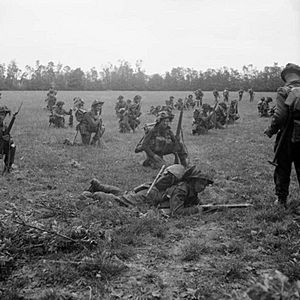
Bad weather made the start of Operation Epsom difficult on 26 June. Rain made the ground muddy, and heavy mist in the UK grounded aircraft. This meant planned bombing support was cancelled. However, the RAF in Normandy could provide air support throughout the day.
The 49th (West Riding) Infantry Division continued Operation Martlet. The Germans slowed their advance and then launched a tank counter-attack. This attack gained some ground but was stopped by British tanks. Later, the Germans learned of the larger British offensive and pulled back their tanks. The 49th Division continued to advance, stopping just north of Rauray.
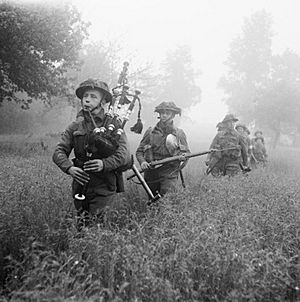
At 7:30 AM, the 44th (Lowland) Infantry Brigade and the 46th (Highland) Infantry Brigade of the 15th (Scottish) Infantry Division began their main attack. They were supported by the 31st Tank Brigade and a rolling artillery barrage. The 46th Brigade initially advanced without tanks due to minefields. The 2nd Battalion, Glasgow Highlanders met light resistance. But the 9th Battalion The Cameronians ran into strong German fire. By midday, both battalions were fighting for their first targets, Cheux and Le Haut du Bosq.
The 44th Brigade faced little opposition at first. But then they came under heavy machine gun fire. By midday, the 6th Battalion, The Royal Scots Fusiliers and the 8th Battalion, The Royal Scots believed they had captured Sainte Manvieu and La Gaule. However, some German soldiers were still holding out. German tanks and infantry counter-attacked Sainte Manvieu twice but were pushed back by heavy artillery fire. The Germans in Rauray, which was still in their hands, fired artillery and tank shells at the British, causing many casualties in Cheux.
Later that day, a reconnaissance unit from the 11th Armoured Division moved towards the Odon River. They faced delays due to minefields and German resistance. By 2:30 PM, they reached a ridge south of Cheux. There, they were attacked by German Panzer IVs, Tiger tanks, and other armored vehicles. More British tanks arrived, but strong German resistance stopped any further advance. By the end of the day, the 11th Armoured Division had lost 21 tanks.
At 6:00 PM, the 227th (Highland) Brigade joined the battle. Only two companies of the 2nd Battalion Gordon Highlanders made significant progress. They entered the northern part of Colleville by 9:00 PM. But they were soon cut off by German counter-attacks. After heavy fighting, one company managed to break out. To stop the British, Field Marshal Rommel ordered all available German units to help that evening.
June 27: Crossing the Odon
The Germans thought the British attack had been stopped. But on 27 June, the British continued their advance. On the right side of the British attack, the Germans launched a counter-attack with 80 tanks. But British artillery fire broke it up. The 49th (West Riding) Infantry Division then resumed its efforts to secure the British flank. Rauray was finally taken by the 49th Division at 4:00 PM after more heavy fighting. This denied the Germans an important observation point.
Operation Epsom continued at 4:45 AM. The 10th Battalion, Highland Light Infantry, tried to reach the Odon crossing at Gavrus. They met strong German resistance and could not advance all day. Both sides suffered many casualties. At 7:30 AM, the 2nd Battalion, Argyll and Sutherland Highlanders, attacked to capture the Odon crossing at Tourmauville. They advanced easily at first. But at Colleville, a small German force with 88 mm guns caused heavy losses. The British finally took the bridge at Tourmauville around 5:00 PM, establishing a bridgehead. By 7:00 PM, some British tanks and infantry had crossed the Odon.
The rest of the 15th (Scottish) Infantry Division was being replaced by the 43rd (Wessex) Infantry Division. When the 5th Battalion, Duke of Cornwall's Light Infantry, moved into Cheux, they found that German soldiers had reoccupied the empty positions. After fighting to recapture the area, they were counter-attacked by German Panther tanks. The attack broke through Cheux, destroying several British anti-tank guns. More German attacks were stopped, but the entire front was full of small battles. The Scottish infantry and armored brigades expanded the area north of the Odon. They also secured the rear of the Argyll and Sutherland Highlanders. Later that evening, soldiers from the 11th Armoured Division were moved through the narrow "Scottish Corridor" to reinforce the bridgehead.
June 28: German Counter-Attacks
In the early hours of 28 June, more German forces arrived. At 8:10 AM, General Friedrich Dollmann, the German 7th Army commander, ordered a counter-attack south of Cheux. However, his units were not ready. Dollmann then died suddenly, causing confusion in the German command. Later, Paul Hausser was appointed commander of the 7th Army.
At 5:30 AM, parts of the 15th (Scottish) Infantry Division attacked to capture Grainville-sur-Odon. After shelling and close-quarters fighting, the Scots secured the village by 1:00 PM. German counter-attacks followed but were pushed back. At 6:00 AM, the Germans launched two strong attacks to cut off the British advance. One German group attacked north of the Odon. They reached Mouen and Tourville, but the British counter-attacked, leading to heavy fighting. The Germans gained control of Mouen, but British counter-attacks stopped them from advancing further.
South of the Odon, at 9:00 AM, the Argyll and Sutherland Highlanders advanced to capture a bridge north of Gavrus. After heavy fighting, both the village and bridge were in Scottish hands. Infantry from the 11th Armoured Division expanded the bridgehead by taking Baron-sur-Odon. British tanks and infantry advanced on Hill 112. They secured its northern slope and pushed defenders from the top. But they could not advance further due to Germans dug in on the other side. The 11th Armoured Division lost nearly 40 tanks on the hill by the end of the day.
June 29: Intense Fighting and German Plans
The weather improved, allowing Allied aircraft to harass German preparations for a counter-attack. British commanders suspected a German counter-attack was coming. They decided to go on the defensive. British planes attacked German supply areas, claiming to destroy over 200 vehicles.
The British also launched some attacks. At 8:00 AM, the 1st Battalion Worcestershire Regiment attacked Mouen. By 11:00 AM, they had pushed back the German soldiers. The 7th Battalion Somerset Light Infantry then moved up and dug in. Another British brigade cleared woods and orchards around Tourville-sur-Odon. An attempt by the 15th Division to link up with the forces holding the Gavrus bridges failed. This left the Gavrus position isolated.
The German counter-attack began at 2:00 PM. The 9th SS Panzer Division attacked Grainville, le Haut du Bosq, and le Valtru, aiming for Cheux. British soldiers were overrun, and German tanks and infantry entered le Valtru. British anti-tank guns destroyed four German tanks there. Confused, hand-to-hand fighting took place outside Grainville. The Germans captured a key wood but were forced back by a British counter-attack. By nightfall, British infantry controlled Grainville.
Around 4:00 PM, the British captured a German officer with maps and plans for new attacks. Around 6:30 PM, the Germans attacked the 15th (Scottish) Infantry Division. German tanks and infantry broke through British defenses. Some advanced two miles before meeting strong resistance. By 11:00 PM, the 9th SS Panzer attack was stopped.
The 10th SS Panzer Division launched its attack later, at 2:30 PM. After five hours of battle, the Scottish infantry defending Gavrus were pushed back. An artillery bombardment forced the Germans to withdraw. The Germans claimed to have destroyed 28 British tanks, while the British recorded losing 12.
Believing more German attacks would follow, the British reinforced the Odon bridgehead. They also pulled back some units to strengthen their defenses. The 29th Armoured Brigade was withdrawn north across the river after dark.
June 30: End of Epsom
The Germans continued their offensive during the night of 29–30 June, hoping to avoid Allied air support. The 9th SS Panzer Division renewed its attacks against Grainville-sur-Odon and le Valtru. But they made little progress against the British. At 1:20 AM, the 10th SS Panzer Division moved towards Hill 112. At dawn, they attacked the British positions, unaware that the British had pulled back. By noon, the Germans had occupied the hill without opposition. A British counter-attack broke up a follow-up attack towards Baron-sur-Odon.
The German commander, Bittrich, called off further attacks against the British VIII Corps. That evening, Hausser, commanding the 7th Army, reported that his counter-attacks were stopped due to "tough enemy resistance" and heavy Allied artillery fire. Unaware of this, and believing more German attacks would come, the British commander Dempsey ended Operation Epsom. The fighting gradually calmed down, though both sides continued to shell each other. The battleship HMS Rodney bombed villages suspected of holding German headquarters. With no more British attacks planned, the Gavrus bridges were given up, and the Scottish defenders pulled back across the Odon. At 8:30 PM, the town of Villers-Bocage, important for German traffic, was destroyed by 250 RAF bombers.
July 1: Final German Attacks
The German II SS Panzer Corps resumed its counter-offensive on 1 July. They spent most of the previous day regrouping. The Germans took the village of Baron-sur-Odon quickly. But a British tank counter-attack retook it by noon. Heavy shelling broke up other German attacks from Hill 112. British patrols later found many dead German soldiers on the northern slope of the hill.
The 9th SS Panzer Division spent the day trying to break through British lines. They advanced behind a smoke screen and broke through the outer British defenses. But the Germans were stopped by secondary positions. Further German attacks throughout the day were met with intense artillery fire and made no progress. In the early evening, a British counter-attack with Sherman and flame-throwing Churchill Crocodile tanks restored the original front line. The attacks were costly for both sides. The British claimed to have destroyed 30 German tanks.
After the Battle
Casualties and Losses
Operation Epsom was very costly for both sides. The 15th (Scottish) Infantry Division suffered over 2,300 casualties, including 288 killed. Other British units had about 2,500 casualties. The 11th Armoured Division and 43rd (Wessex) Infantry Division had 1,256 casualties, with 257 killed in the 11th Armoured Division. From 26 to 30 June, the British VIII Corps had 470 deaths, 2,187 wounded, and 706 missing soldiers. On 1 July, another 488 men were killed or wounded, and 227 were missing.
The Germans suffered over 3,000 casualties during Epsom. The 9th SS Panzer Division had 1,145 casualties, the 10th SS Panzer Division had 571, and the 12th SS Panzer Division had 1,244. The Germans lost 126 tanks from 26 June to 1 July, including 41 Panthers and 25 Tigers. Some sources say the British lost 150 tanks.
Next Steps
The heavy fighting led to disagreements in the German high command. General Günther von Kluge replaced Gerd von Rundstedt as Commander in Chief West. Another German commander was also replaced.
During a quiet period, both sides changed their troop positions. The British 53rd (Welsh) Infantry Division replaced the 15th (Scottish) Infantry Division. The 43rd (Wessex) Infantry Division took over the Odon bridgehead. The Germans brought up the 277th Infantry Division to replace some of their panzer divisions.
A few days later, the British Second Army launched Operation Charnwood to take Caen. This included an attack on Carpiquet, which had been planned earlier. In a direct attack, the northern part of Caen was captured. The rest of the city was taken in later operations in mid-July. Fighting in the Odon Valley continued. On 10 July, Operation Jupiter was launched to push back German forces near Baron-sur-Odon and retake Hill 112. The Second Battle of the Odon began on 15 July. This battle was meant to distract German attention from another major British attack. It was one of the bloodiest fights of the campaign.
Battle Honours
The British military system recognized participation in Operation Epsom. In 1956, 1957, and 1958, 34 units received the battle honour Odon. This was for their service around the river from 25 June to 2 July 1944. Specific honors were also given for actions during the operation: Fontenay le Pesnil, Cheux, Tourmauville Bridge, and Defence of Rauray.


